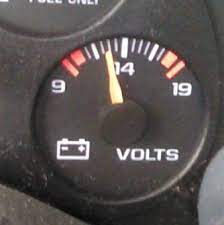A voltmeter is a device that measures electrical potential difference between two points in an electric circuit. It consists of a moving coil meter mechanism, which carries the pointer and is mechanically connected to the input terminals. This meter displays the voltage in volts, much like the speedometer of a car shows you how fast it’s going. Unlike most other meters, however, this one will show you when there’s a problem—and that can be anything from low battery power to damaged wiring or corrosion on your car’s battery terminal connections. So why does your car’s voltmeter fluctuate?
Voltmeters are attached directly to the battery or electrical system of a vehicle in order to measure its current. The reason why your voltmeter fluctuates is because it’s reading how much current is going through at any given moment—which means that if something changes while driving (like turning on headlights), then so will this reading. In short: fluctuations happen due to fluctuations within what they’re measuring!
The alternator is not providing a consistent amount of voltage
If your alternator isn’t providing a consistent amount of voltage, there are a few possible causes: it could’ve failed completely and will need to be replaced, or its parts might need to be cleaned and repaired. Its bearings may also be worn out and in need of repair. Alternators contain brushes that make contact with the slip rings and rectifiers, which can wear down over time. If the brushes aren’t making good contact with these parts, it could cause the alternator to fail.
When an alternator starts to fail, you’ll likely notice warning signs such as dim headlights or interior lights when you’re idling (low voltage), or flickering interior lights (high voltage). If your alternator is failing completely, your car may not have any power at all while running—the battery will start the engine but then receive no charge for continued operation. You can test for this condition by turning on the car’s parking lights; if they stay on after removing the ignition key from the car’s master switch, it indicates you have an alternator problem
The battery has gone bad
When the car battery is dying, it won’t be able to maintain the charge. This can cause the car’s voltage meter to fluctuate. Since it’s a problem with the battery, you could replace that and see if that corrects the problem. Another possible solution is to get your alternator checked and/or replaced, but it’s not as likely that will solve your issue as just replacing the battery.
The alternator helps provide electricity to all of the components in your vehicle so they don’t have to draw from your battery’s reserve power. The alternator can only charge a healthy battery though – when there’s damage or corrosion inside an old car battery, it won’t be able to hold a charge well at all. The best thing you can do is test your car’s voltage with a multimeter (a device used for measuring electrical currents) or a voltmeter (a device used for measuring electric potential difference). This will help you determine whether or not your battery is beyond saving and needs replacing.
There’s a mysterious electrical draw
If you’ve ruled out short-term voltage fluctuations (visibility problems and driving with your lights on) and the reading is still disconcertingly low, it’s time to check for a parasitic drain.
You’ll need a multimeter to test for a parasitic drain. An electrical current that isn’t actually powering anything can pull voltage from your battery, draining it while the car is off and preventing it from charging when you’re driving. If this is happening, you might be able to hear your alternator whining as it struggles to keep up with the extra demand.
If there’s no sign of a parasitic drain, you can check for frayed wires or broken/loose connections in your electrical system. If a wire has fallen apart, or if one of the connections in your alternator or voltage regulator has worn away, that could create a situation where energy isn’t being transferred properly between components.
Finally, faulty components could be causing an unexplained drop in voltage—possibly a small problem at first that’s been getting worse over time. Component issues are often the result of wear and tear from dirt or old age; they can also happen if you’ve gone through an accident that damaged any part of your engine system. A faulty ignition switch can have this effect as well since it prevents power from flowing properly between different parts of the vehicle.
In order for your car to function properly, the alternator needs to be providing a consistent charge to the battery.
First, it’s important to understand that your car battery isn’t a generator—it’s a storage device. The alternator is the generator, and its job is to provide power while your engine is running. It does this by converting mechanical energy into electrical energy, which then passes through an internal regulator that ensures the correct voltage. On the other side of this regulator are either two or three wires—the first goes back into the alternator as a means of powering it and completing the circuit; the other(s) go out to power various electronic parts in your car (headlights, cigarette lighter sockets, etc.).
If you’re looking at that diagram and wondering how there could possibly be a consistent flow of electrons in and out of the alternator when only one wire connects directly to it (leaving no clear path for electrons to return), you’re asking exactly what I asked myself when I first learned about it. I’ll let each reader ponder on their own how such a seemingly impossible thing could work.

